
Mammoth Cave National Park is a national park in south-central Kentucky, US. It encompasses portions of Mammoth Cave, the longest known cave system in the world. The park's 52,830 acres (21,380 ha) are located primarily in Edmonson County, with small areas extending eastward into Hart and Barren counties. The Green River runs through the park, with a tributary called the Nolin River feeding into the Green just inside the park.

White County is a county located in the U.S. state of Tennessee. As of the 2020 census, the population was 27,351. Its county seat is Sparta.

Elizabethton is a city in, and the county seat of Carter County, Tennessee, United States. Elizabethton is the historical site of the first independent American government located west of both the Eastern Continental Divide and the original Thirteen Colonies.
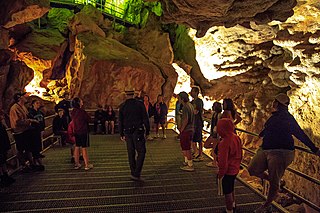
Jewel Cave National Monument contains Jewel Cave, currently the fifth longest cave in the world and second longest cave in the United States, with 219.77 miles (353.69 km) of mapped passageways as of March 2024. It is located approximately 13 miles (21 km) west of the town of Custer in Black Hills of South Dakota. It became a national monument in 1908.

Kazumura Cave is a lava tube and has been surveyed at 40.7 miles long and 3,614 feet deep making it the longest and deepest lava tube in the world. The cave is located on the island of Hawaiʻi on the eastern slope of Kīlauea. Kīlauea is the most recently active volcano on the Big Island. The ʻAilāʻau lava flow that contains Kazumura Cave originated from the Kīlauea Iki Crater about 500 years ago.

Craighead Caverns is an extensive cave system located in between Sweetwater and Madisonville, Tennessee. It is best known for containing the United States' largest and the world's second largest non-subglacial underground lake, The Lost Sea. In addition to the lake, the caverns contain an abundance of crystal clusters called anthodites, stalactites, stalagmites, and a waterfall.
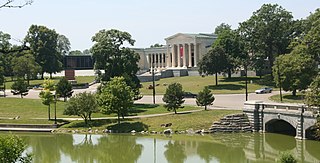
Delaware Park–Front Park System is a historic park system and national historic district in the northern and western sections of Buffalo in Erie County, New York. The park system was designed by Frederick Law Olmsted and Calvert Vaux and developed between 1868 and 1876.
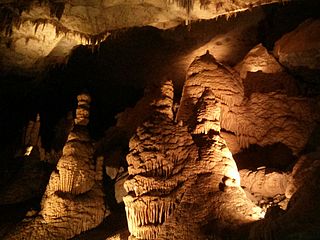
Cumberland Caverns is a national natural landmark and show cave located in McMinnville, Tennessee. It is the second longest cave in Tennessee and makes the list of longest caves in the United States and in the world.

Wes Skiles Peacock Springs State Park is a 733-acre (297 ha) Florida State Park located on Peacock Springs Road, two miles (3 km) east of Luraville and on State Road 51, 16 miles (26 km) southwest of Live Oak, Florida. Activities include picnicking, swimming and diving, and wildlife viewing. Among the wildlife of the park are deer, bobcats, raccoon, squirrels, beaver and otters, as well as turkey, blue heron and barred owls. The park name commemorates the work of diver and explorer Wes Skiles. Prior to 2010 the park was known as Peacock Springs State Park. Amenities include a nature trail, six sinkholes, and Peacock and Bonnet Springs, with miles of underwater caves popular with cave divers. The two springs are tributaries of the Suwannee River. The park is open from 8:00 am till sundown year round.

Dos Ojos is part of a flooded cave system located north of Tulum, on the Caribbean coast of the Yucatán Peninsula, in the state of Quintana Roo, Mexico. The exploration of Dos Ojos began in 1987 and still continues. The surveyed extent of the cave system is 82 kilometers (51 mi) and there are 28 known sinkhole entrances, which are locally called cenotes. In January 2018, a connection was found between Sistema Dos Ojos and Sistema Sac Actun. The smaller Dos Ojos became a part of Sac Actun, making the Sistema Sac Actun the longest known underwater cave system in the world.
Lookout Mountain Caverns is the second-longest known cave in Hamilton County, Tennessee. Its mapped length of 2.481 miles places it at 361st on the United States Long Caves List. Unofficially, anecdotal reports of cave expeditions have exceed 12 miles with legends exceeding 82 miles. The cave is closed and public access is forbidden.

The Museum of the Earth is a natural history museum located in Ithaca, New York. The museum was opened in 2003 as part of the Paleontological Research Institution (PRI), an independent organization pursuing research and education in the history of the Earth and its life. Both PRI and the Museum of the Earth are formally affiliated with Cornell University. The Museum of the Earth is home to Earth science exhibits and science-related art displays with a focus on the concurrent evolution of the Earth and life.
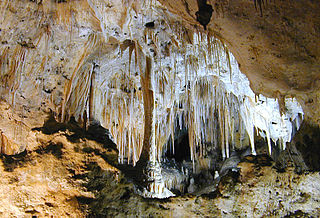
Carlsbad Caverns National Park is an American national park in the Guadalupe Mountains of southeastern New Mexico. The primary attraction of the park is the show cave Carlsbad Cavern. Visitors to the cave can hike in on their own via the natural entrance or take an elevator from the visitor center.

Onondaga Cave State Park is a Missouri state park located on the Meramec River approximately 5 miles (8.0 km) southeast of the village of Leasburg. The park was established in 1982. Park activities include cave tours, camping, fishing, hiking, picnicking, and swimming.
Spring Valley Caverns is a cave system in southeastern Minnesota near Spring Valley, Minnesota in Fillmore County. The region is within the Driftless Area, a region noted for its karst topography, which includes caves and sinkholes.
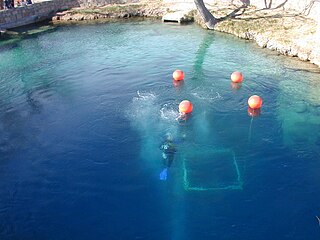
The Blue Hole of Santa Rosa, or simply the Blue Hole, is a circular, bell-shaped pool or small lake located along Route 66 east of Santa Rosa, New Mexico that is a tourist attraction and swimming venue, and one of the most popular dive destinations in the US for scuba diving and training. The Blue Hole is an artesian well and cenote that was once used as a fish hatchery.
Tyson Spring Cave is a cave located in southeastern Minnesota's Fillmore County. The region is within the Driftless Area, a region noted for its karst topography, which includes caves and sinkholes. Tyson's cave is a solutional cave privately owned by the Minnesota Cave Preserve. It is known for the extinct ice-age bones found scattered throughout the cave rooms. The majority of this extensive cave is approximately 120 feet below the surface and is estimated to be 3.5–5 miles in length, making it the 258th longest cave in the United States.

Cherney Maribel Caves County Park is a county park located near Maribel in Manitowoc County, Wisconsin. The park occupies 75 acres along the West Twin River. Cherney Maribel Caves consists of eleven caves along a rugged cliff line that runs parallel with the West Twin River. Maribel New Hope Cave, Tartarus Cave, Sinkhole Cave and Split Rock Cave are all established gated caves that need guides to visit the entire caves, they are gated due to past vandalism to the Speleothems and protect the current Speleothems.
The Fisher Ridge Cave System is a cave system located in Hart County, Kentucky, United States, near Mammoth Cave National Park. As of November 2019 it had been mapped to a length of 130.001 miles (209.216 km), making it the fifth-longest cave in the United States and the tenth-longest in the world.















